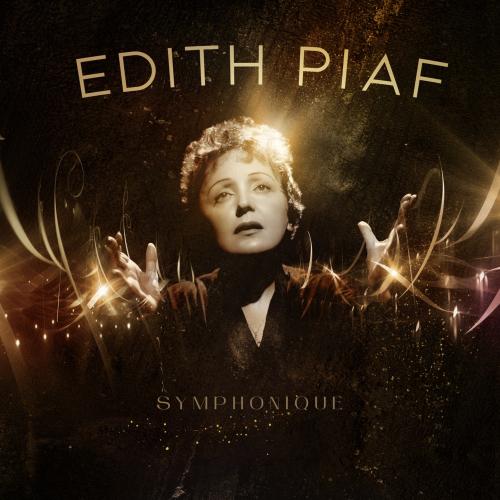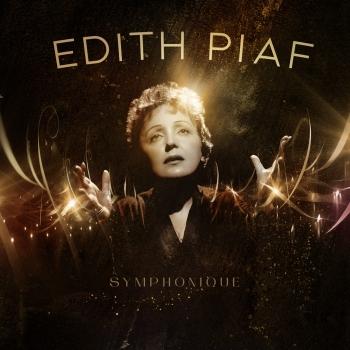
Symphonique Edith Piaf & Legendis Orchestra
Album Info
Album Veröffentlichung:
2023
HRA-Veröffentlichung:
13.10.2023
Label: Parlophone (France)
Genre: Vocal
Subgenre: Vocal Pop
Interpret: Edith Piaf & Legendis Orchestra
Das Album enthält Albumcover
Entschuldigen Sie bitte!
Sehr geehrter HIGHRESAUDIO Besucher,
leider kann das Album zurzeit aufgrund von Länder- und Lizenzbeschränkungen nicht gekauft werden oder uns liegt der offizielle Veröffentlichungstermin für Ihr Land noch nicht vor. Wir aktualisieren unsere Veröffentlichungstermine ein- bis zweimal die Woche. Bitte schauen Sie ab und zu mal wieder rein.
Wir empfehlen Ihnen das Album auf Ihre Merkliste zu setzen.
Wir bedanken uns für Ihr Verständnis und Ihre Geduld.
Ihr, HIGHRESAUDIO
- Michel Rivgauche, Edith Piaf, Angel Cabral:
- 1 La foule (Symphonique, orch. Nathan Stornetta) 02:59
- Marguerite Monnot:
- 2 Milord (Symphonique, orch. Samuel Pegg) 04:33
- Norbert Glanzberg:
- 3 Mon manège à moi (Tu me fais tourner la tête) [Symphonique, orch. Nathan Stornetta] 03:13
- Charles Dumont:
- 4 Non, je ne regrette rien (Symphonique, orch. Martin Batchelar) 02:25
- Marguerite Monnot, Edith Piaf:
- 5 Hymne à l'amour (Symphonique, orch. Samuel Pegg) 03:31
- Mike Stoller, Jerry Leiber:
- 6 L'homme à la moto (Symphonique, orch. Martin Batchelar) 02:07
- Norbert Glanzberg:
- 7 Padam, Padam (Symphonique, orch. Samuel Pegg) 03:21
- Hubert Giraud:
- 8 Sous le ciel de Paris (Symphonique, orch. Martin Batchelar) 03:26
- Charles Dumont:
- 9 Mon dieu (Symphonique, orch. Nathan Stornetta) 03:28
- Marc Heyral:
- 10 Notre dame de Paris (Symphonique, orch. Samuel Pegg) 03:13
- Michel Emer:
- 11 A quoi ça sert l'amour ? (En duo avec Théo Sarapo) [Symphonique, orch. Martin Batchelar] 02:31
- Louiguy:
- 12 La vie en rose (Symphonique, orch. Nathan Stornetta) 03:16
Info zu Symphonique
Edith Piaf, die 60 Jahre nach ihrem Tod ihre größten Lieder vorträgt, begleitet in London von einem Symphonieorchester mit 60 Musikern... Was als Science-Fiction gelten könnte, ist dank renommierter Musiker, Arrangeure und Tontechniker Wirklichkeit geworden.
Sie stellten sich der Herausforderung, neue Orchestrierungen zu schaffen, die für die Ohren von heute geeignet sind, ohne die Nostalgie ihrer Vorgänger zu beeinträchtigen. Indem sie ihre Stimme technisch isolierten, konnten sie den Refrains von damals beweisen, dass sie ebenso unsterblich sind wie ihre Interpretin. Die ikonische Stimme von Edith Piaf wurde von einem Team von Toningenieuren im legendären Abbey Road Studio in London akribisch aus den Originalaufnahmen extrahiert.
Das Album wiederum wurde in den renommierten AIR Studios aufgenommen, die sich ebenfalls in London befinden. Das Orchester besteht aus sechzig sorgfältig ausgewählten Musikern, die das renommierte Legendis Orchestra bilden. Diese Musiker kommen aus einigen der renommiertesten englischen Symphonieorchester, darunter das London Symphonic Orchestra, das Royal Philharmonic Orchestra und das BBC Orchestra. Die Stücke wurden von Martin Batchelar, Samuel Pegg und Nathan Stornetta hervorragend arrangiert.
Für dieses Projekt kooperiert Warner Music Frankreich mit dem Jamais 203 Productions Team, das aus Nathan Stornetta, Samuel Briand, and Jérôme Kuhn besteht. Nathan Stornetta ist Komponist, Produzent und Arrangeur mit einer beeindruckenden Vita. Er war in zahlreichen Filmmusikprojekten beteiligt, darunter insbesondere bei Arbeiten für „Fast & Furious 6“ und das Serienepos „The Bible“. Zwischen 2014 und 2015 hat Stornetta in Los Angeles residiert, wo er als Komponist für Hans Zimmer arbeitete. Die dort entstandenen Kollaborationen umfassen Filme wie „Chappie“, „Premiere Boxing Champions“ (NBC) und Mark Osbournes „Der kleine Prinz“. Die Zusammenarbeit mit Hans Zimmer hält seither an, da Stornetta als Perkussionist ebenfalls Teil des Ensembles von Zimmer ist und bei Touren wir „Hans Zimmer Live“ (2016-2017) oder Aufnahmen wie für „Der König der Löwen“ (2019) beteiligt war. 2018 übernahm Stornetta das Arrangement von drei Songs des James Horner Tributalbums „The Classics“ auf Sony Classical. Seit 2013 ist er der leitende Komponist im Puy de Fou, wo er seine anhaltende Leidenschaft für sein Handwerk fortführt. Samuel Briand ist Toningenieur, Music Supervisor und künstlerischer Leiter. Seit mehr als zehn Jahren arbeitet Briand als Sounddesigner im Puy du Fou, wo er Soundtracks komponiert und die renommiertesten Orchester Europas aufnimmt. Nebenher absolvierte er eine Ausbildung im Bereich der Filmmusik, bei der er an der Seite erfahrener Filmtoningenieure lernte und gemeinsam mit Experten aus Hollywood wie Alan Meyerson, dem Toningenieur hinter Hans Zimmers Arbeiten (darunter Gladiator, Fluch der Karibik, Inception etc.) und Nick Wollage (bekannt für Solo: A Star Wars Story, V für Vendetta, Harry Potter etc.) arbeitete. Zuletzt machte Briand erste Schritte in der Werbebranche mit Arbeiten für Coca-Cola, Disneyland Paris und Canal+. Jérôme Kuhn ist der künstlerische Leiter der NOF – Neue Oper Freiburg, des Prague Symphonic Ensemble sowie des Ensemble Vocal de Villars-sur-Glâne. Er hat mit diversen Ensembles in Frankreich, der Schweiz, England, Deutschland und der Tschechischen Republik gearbeitet, darunter die Academy of Ancient Music, das Orchestre de Chambre fribourgeois, das Nouvel Ensemble Contemporain NEC de la Chaux-de-Fonds, das Prague Philharmonic Orchestra und der Estonian Philharmonic Chamber Choir. Daneben ist er in der Tonträgerindustrie aktiv und wirkt an Produktionen für Netflix und HBO mit, wofür er in Studios wie dem Seine Musicale in Paris, den AIR Studios in London und den Smecky Music Studios in Prag aktiv ist. Nicht zuletzt arbeitet Kuhn eng mit bekannten Künstler:innen wie Mireille Mathieu (Mes Classiques) zusammen.
Edith Piaf, Gesang
Legendis Orchestra
Jérôme Kuhn, Dirigent
Edith Piaf
Legend has it that Edith Piaf was born (as Edith Giovanna Gassion) on a Parisian street corner with two policemen attending. This is not a far-fetched idea, however, and may be true. Ediths mother was an alcoholic Italian street singer and part-time prostitute who neglected her for all of two months and then abandoned her to her father. Ediths father, Jean Gassion, was a famous acrobat who hadnt the time nor the skills to nurture an infant. He dropped the child off with his mother, the madam of a bordello, and she raised Edith through the toddler years.
When Edith was school-aged, her father reclaimed her and made her part of his act, performing in circuses and nightclubs. Although her fathers life was not a stable one, he truly loved Edith and did his best to care for her. By the age of fifteen, though, Edith had had enough of circus life and went back to Paris, where she began singing for money in the streets.
In 1935, Edith was discovered by a nightclub owner named Louis Leplee. Leplees establishment was called Gernys, and was frequented by the upper and lower classes alike, as many Parisian clubs were in those days. Leplee convinced Edith to sing at Gernys despite her extreme nervousness, and gave her the nickname that would stay with her for the rest of her life: Le Mome Piaf (The Little Sparrow). From this she took her stage name.
Ediths specialty was the poignant ballad, and soon all of Paris was talking about the waif with the heartbreaking voice. She began to make friends with famous people, such as the actor Maurice Chevalier and the poet Jaques Borgeat.
In April of 1936 Edith was devastated when her mentor, Louis Leplee, was found murdered in his apartment. She was appalled to be considered a suspect, but knew that her reputation for associating with unsavory characters wasnt helping her in this situation. It was at this low point that she turned to a businessman named Raymond Asso. Though Asso was married, he helped Edith to straighten things out with the police, and they began a tempestuous affair. She handed the reins of her career over to him, and under his management her star ascended. Soon her shows were selling out and her financial prospects improved dramatically.
In 1939, Edith left Asso for Paul Meurisse, a wealthy singer who offered her a way into sophisticated, upper class Paris. While Edith enjoyed her new lifestyle, the relationship was not a happy one. Both partners were stubborn and temperamental, and their arguments often turned violent. They were befriended by the playwright Jean Cocteau, and he based his play Le Belle Indifferent on their twisted love. Edith starred in the first production of the play, in 1940. By this time, the Germans were threatening invasion. Edith performed in many benefits for the French Army, but knew that hope was slim. Meurisse was called up for duty, and Edith was relieved when he was rejected on medical grounds. The two toured the unoccupied areas of France, but were finally forced back to Paris. All artists under the occupation had to have their material vetted by the Nazis. Some were persecuted more than others, and to many people, Edith wasnt persecuted enough. In fact, she performed many times for Nazi parties and banquets. When she moved into an apartment over a bordello, she befriended and entertained members of the Gestapo in her suite. Later she would claim to be a member of the Resistance, but like her friend Maurice Chevalier, she would always be suspect. We do know, however, that she helped at least one Jewish acquaintance, the composer Michael Emer, escape France and death.
During the war, both of Ediths parents reentered her life. She was happy to see her father, and supported him until he died a few years later. Her mother was another story. Edith would often be called to bars or the police station to pick up her inebriated mother. Though she had her hands full with family matters, the war years were arguably her most creative, and she wrote her signature song, La Vie en Rose in the middle of the Occupation. The list of men that Edith went through during this rough time looks like a Parisian phone book, but things werent going to get any better.
After the war, Edith toured Europe, the United States, and South America, becoming an internationally known figure. Then, in 1951, tragedy struck. She was in a horrible car accident, breaking an arm and several ribs. The doctors prescribed morphine, and she also began drinking heavily to ease the pain. Soon Edith was recognized cruising the bars of Paris, picking up strange men to assuage her loneliness. In 1952, she settled down a bit when she married songwriter Jaques Pills, but Pills was also an alcoholic, and did nothing to discourage her drinking. He did love her, however, and provided her with the most stable relationship shed ever known.
They were divorced by 1957 however, and in 1960 Piaf recorded Non, je ne regrette rien and soon after started a romance with Theo Sarapo, 12 years her junior which led to their marriage in 1962.
In early 1963, Edith recorded her last song, Lhomme de Berlin. She died on October 11 of that year. (Source: singers.com)
Dieses Album enthält kein Booklet










